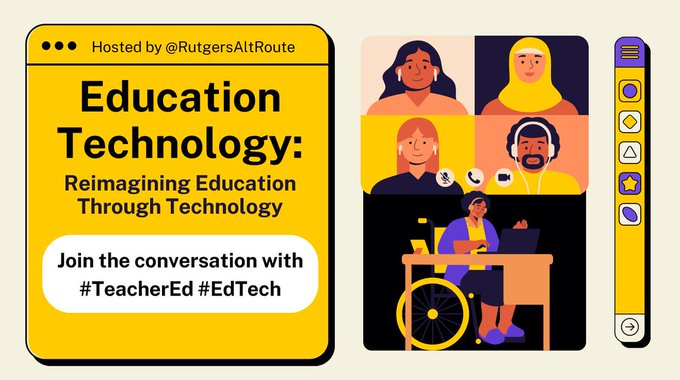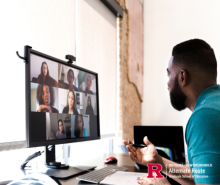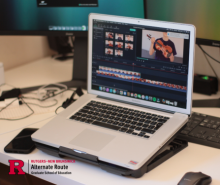Insights from a Dynamic #EdTech Chat among New Jersey Teachers

On Saturday, November 16th, while many enjoyed a leisurely morning, Rutgers Alternate Route teachers demonstrated their commitment to professional growth by participating in an invigorating #EdTech chat. This virtual gathering brought together education technology experts from across New Jersey and California to discuss strategies for engaging digitally savvy students and leveraging technology in educational practices. Using the hashtags #EdTech and #TeacherEd, educators shared and discovered technology-centered ideas, responding rapidly to questions posed by the Rutgers Alternate Route host account. In just 60 minutes, hundreds of participants tackled five questions on technology use in schools, showcasing the power of social media for professional development.
The chat featured an impressive lineup of education leaders, including Derek Tranchina, Ed.D., a 15-year veteran educator and administrator currently serving as the Director of Special Projects for the Monmouth-Ocean Educational Services Commission in New Jersey; Kaylee Baldwin, a New Jersey certified special needs educator who currently works as an Instructional Technology Facilitator and Google for Education Champion; Alex Isaacs an Educational Technology Coach at Long Branch Public Schools in New Jersey; and Ashley Shanley, Instructional Technology Coach at Berkeley Heights Public Schools in NJ; and California educator Adam Juarez, an Educational Technology & Integrated Studies Consultant for Tulare County Office of Education.

The chat's effectiveness was clearly demonstrated by the significant shift in participants' self-reported knowledge levels related to leveraging technology in educational practices. At the outset, only 25% of participants considered themselves "very knowledgeable," with the majority (72%) feeling "somewhat knowledgeable" and a small fraction (3%) reporting they were "not at all knowledgeable." However, by the conclusion of the chat, a remarkable transformation had occurred. The proportion of "very knowledgeable" participants more than doubled to 60%, while those feeling "somewhat knowledgeable" decreased to 39%. Notably, the "not at all knowledgeable" category shrank to just 1%. This dramatic increase in perceived expertise underscores the power of collaborative learning and idea-sharing among educators, highlighting the chat's success in enhancing participants' confidence and knowledge in educational technology.

Technology Across Subjects
Classroom technology integration has become widespread across various subjects, enhancing the learning experience for students. Chromebooks and interactive learning programs like Successmaker and Blooket are now commonplace in many classrooms, providing students with digital tools for interactive and engaging learning. Smart Boards have revolutionized the way students interact with educational content, allowing them to write notes, highlight text, and engage with materials directly. This content can then be cast onto individual Chromebooks, ensuring all students have a clear view of the material. In Physical Education (PE) classrooms, technology is being utilized to demonstrate skills, analyze movements, and track student progress toward PE goals. Even in traditionally hands-on subjects like woodworking, technology has found its place, with students using it for 3D modeling, drafting, and creating video assignments related to physics and aerodynamics.
Supporting Diverse Learners
Technology has proven particularly beneficial for diverse learner groups, adapting to various educational needs. For Pre-K, ABA (Applied Behavior Analysis), and LLD (Language Learning Disabled) students, educational apps have transformed the learning of basic skills into interactive and engaging activities. These apps use games and activities to teach fundamental concepts like colors, shapes, and numbers, helping to maintain young children's focus. In ESL (English as a Second Language) classrooms, teachers utilize a range of digital platforms such as VHLCentral.com, Schoology, and Kahoot to teach English grammar, reading, and writing skills. Google Classroom has become a valuable tool for sharing bilingual resources, including slides, vocabulary words with images, word banks, and quizzes, supporting bilingual learners in their language acquisition journey.
Overcoming Challenges
While technology offers numerous benefits, educators also face challenges in its implementation. Common obstacles include infrastructure issues such as unreliable Wi-Fi and outdated devices, which can hinder the seamless integration of technology in the classroom. The lack of comprehensive teacher training on effective tech integration has been a significant barrier, though this is being addressed through professional development workshops focusing on classroom technology integration. Additionally, monitoring student use of technology and keeping them on task can be challenging, requiring teachers to establish clear routines and maintain high expectations for technology use.
Collaboration and Professional Development
Technology has significantly transformed how educators collaborate and pursue professional development. Online platforms now enable teachers to connect with colleagues globally, sharing resources and ideas across geographical boundaries. While some educators still prefer traditional in-person collaboration for discussing lessons and classroom management strategies, many recognize that technology expands their professional learning opportunities. Peer observations and attendance at workshops continue to provide valuable insights, allowing teachers to learn from colleagues in different districts and demographics.
Communicating with Families
Parent-teacher communication has also been revolutionized by technology. Tools like ClassDojo, email, and virtual meetings have made it easier to keep families informed about student progress. AI-powered translation tools have become particularly valuable in bridging language barriers, helping non-English speaking parents stay connected with their children's education. Many schools now create weekly newsletters using digital platforms like Google, which are shared electronically to keep parents updated on classroom activities and student achievements. These technological innovations have made communication more immediate, accessible, and inclusive, breaking down traditional barriers between schools and families.
While technology in education presents both opportunities and challenges, many educators find that the benefits outweigh the drawbacks. As one teacher aptly puts it, "Technology provides many benefits for a teacher, such as accessibility to resources that would otherwise be much harder to come by!" By embracing technology and developing strategies to overcome its challenges, educators are creating more dynamic, inclusive, and effective learning environments for their students. The chat content, which is curated in the Wakelet collection here, can be mined for all of the rich teaching tools and tips participants shared.

 Sharlene Laud has extensive experience in education from K-12 to higher education and holds a Doctorate in Education from the Rutgers Graduate School of Education. Dr. Laud is the Assistant Director of the Rutgers-GSE Alternate Route Program in the Department of Learning and Teaching. Follow her on X @sharlene_laud
Sharlene Laud has extensive experience in education from K-12 to higher education and holds a Doctorate in Education from the Rutgers Graduate School of Education. Dr. Laud is the Assistant Director of the Rutgers-GSE Alternate Route Program in the Department of Learning and Teaching. Follow her on X @sharlene_laud





